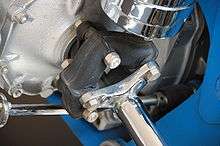Flexure bearing
A flexure bearing is a bearing which allows motion by bending a load element.
A typical flexure bearing is just one part, joining two other parts. For example, a hinge may be made by attaching a long strip of a flexible element to a door and to the door frame. Another example is a rope swing, where the rope is tied to a tree branch.

Flexure bearings have the advantage over most other bearings that they are simple and thus inexpensive. They are also often compact, lightweight, have very low friction, and are easier to repair without specialized equipment. Flexure bearings have the disadvantages that the range of motion is limited, and often very limited for bearings that support high loads.
A flexure bearing relies on the bearing element being made of a material which can be repeatedly flexed without disintegrating. However, most materials fall apart if flexed a lot. For example, most metals will fatigue with repeated flexing, and will eventually snap. Thus, one part of flexure bearing design is avoiding fatigue. Note, however, that fatigue is important in other bearings. For example, the rollers and races in a rolling-element bearing fatigue as they flatten against each other.
Flexure bearings can give very low friction and also give very predictable friction. Many other bearings rely on sliding or rolling motions (rolling-element bearings), which are necessarily uneven because the bearing surfaces are never perfectly flat. A flexure bearing operates by bending of materials, which causes motion at microscopic level, so friction is very uniform. For this reason, flexure bearings are often used in sensitive precision measuring equipment.
Flexure bearings are not limited to low loads, however. For example, the drive shafts of some sports cars replace cardan universal joints with an equivalent joint called a rag joint which works by bending rubberized fabric. The resulting joint is lighter yet is capable of carrying hundreds of kilowatts, with adequate durability for a sports car.
Because flexure bearings do not rely on sliding or rolling motions, they do not require lubrication. Consequentially, they can be employed in environments hostile to lubricants: underwater, in a vacuum (where grease will boil) and at elevated temperatures.
Many flexure bearings are combined with other elements. For example, many motor vehicles use leaf springs. The spring both holds the position of the axle as the axle moves (flexure bearing) and provides force to support the vehicle (springing). In many cases it is not clear where flexure bearing leaves off and something else takes up. For example, turbines are often supported on flexible shafts so an imperfectly balanced turbine can find its own center and run with reduced vibration. Seen one way, the flexible shaft includes the function of a flexure bearing; seen another, the shaft is not a "bearing".
The motion of more than one flexure bearing can be combined to create a desired motion. In the early 1980s work began on a cryogenic cooler for use in satellites which supported the pistons in bores using spiral flexure bearings. These flexures produce motion in a precise axis which allowed the fit between the pistons and bores to be very close but without metal to metal sliding contact.[1] Derivatives of this cooler design are still in use in satellites to this day.
See also
References
- ↑ Ross, R. G. Jr; Aerospace Coolers: a 50-Year Quest for Long-life Cryogenic Cooling in Space
External links
- NASA Tech Brief
- http://www-personal.umich.edu/~awtar/PHD/Diaphragm.pdf
- Kinematic Models for Design Digital Library (KMODDL) - Movies and photos of hundreds of working mechanical-systems models at Cornell University. Also includes an e-book library of classic texts on mechanical design and engineering.
- Weinstein, Warren D., "Flexure-Pivot Bearings", Machine Design, Part 1, June 10, 1965, Part 2, July 8, 1965 - Spring rates, bearing types, single and multi-strip design, material types, hysteresis and fatigue
- Weinstein, Warren D., "Microperformance of Metals". Machine Design, September 11, 1969 - Material relaxation and rolamite
- The Bal-tec Flexural Encyclopedia